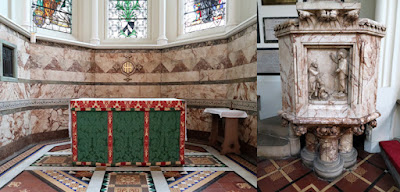 |
| London's first drinking fountain |
Leaving the Church of St. Bartholomew the Great, although I had achieved my objectives for the day, it was only 4 o’clock in the afternoon and I therefore continued my exploration of the City of London by having a quick look at the east building of Smithfield Market.
Built in Portland stone and red brick in 1868 to a design by the City architect, Sir Horace Jones, I was most interested in the stone carvings that decorate the entrances and to the base of the corner towers and the red granite to the Great War Memorial in the interior.
Making my way anticlockwise around West Smithfield, I was astonished to see the double cattle trough and drinking fountain, which has been fashioned from a single piece of grey granite that comes from the Cornubian Batholith in south-west England.
Continuing to the Church of St. Bartholomew the Less, which is the chapel and church for Barts Hospital, the C15 Kentish Rag tower and the rest of the mediaeval fabric is dominated by the octagonal nave (1825) and a five sided chancel that was added during the restoration of 1863 – built in brick and stucco.
In the interior, which is plastered and without much archaeological interest, I only spent a few minutes looking around and taking some general photographs, with the highlights being the alabaster panelled reredos and the pulpit.
Passing through a passageway to the West Smithfield entrance to Barts Hospital, I stopped briefly to photograph the St. Bart's War Memorial, comprising inscriptions to the victims of the Great War – cut into Portland stone – with the names of those who died in WWII being inscribed into the arches above.
Continuing down Giltspur Street, I arrived at the old watch house, dating to 1791, which is attached to the Church of St. Sepulchre and was destroyed during the Blitz and then rebuilt in 1962. Constructed in Portland stone, it is the last of its kind – an early form of a police station – that survives in the City of London.
The Church of St. Sepulchre, the National Musicians’ Church, dates back to the C12, but on the exterior I only briefly looked at the Kentish Rag tower (c.1450) and the south elevation of the east end, which was rebuilt after the church was gutted by the Great Fire of London.
The church was closed at the time and I only stopped to take a few photographs, including the three storey porch, which is built in what looks like Bath Stone. Here, beneath the dirt, this Jurassic oolitic limestone, which became very popular in London after the building of the Kennet and Avon Canal, has developed its typical honey coloured patina.
On the south-east corner of the churchyard, the boundary wall contains London’s first drinking fountain, made of Portland stone and Peterhead granite – including a xenolith - which is very unusual in that it still retains a pair of drinking cups that are fastened by chains.
At this point, I decided that a pint of Fuller’s London Pride at the Viaduct Tavern – a Grade II Listed public house - was well deserved after 6 hours of non stop activity. Even though I was too busy enjoying my pint at the time to look at the stones, it provides examples of larvikite, Swedish Bon Accord Red and dark grey 'granites’, which were very popular during the second half of the C19.











No comments:
Post a Comment